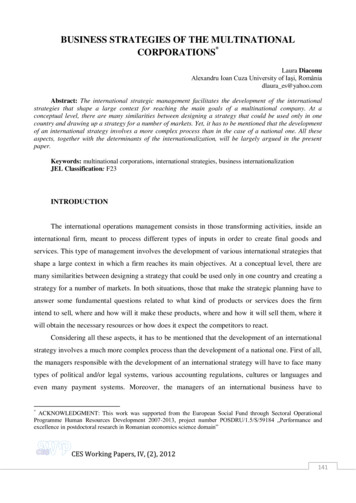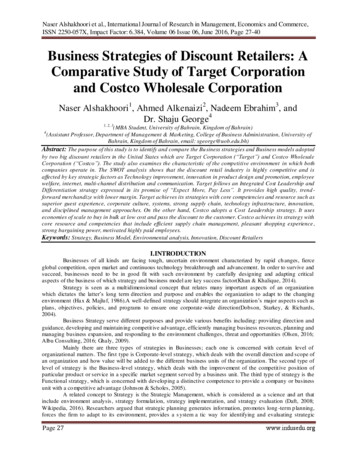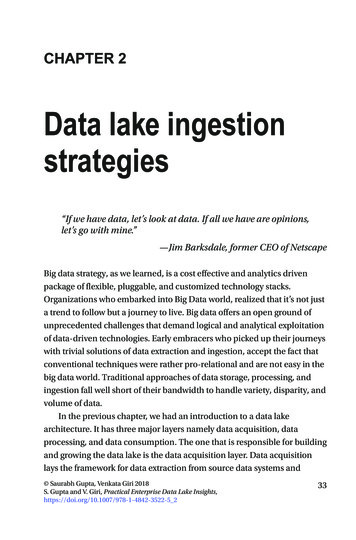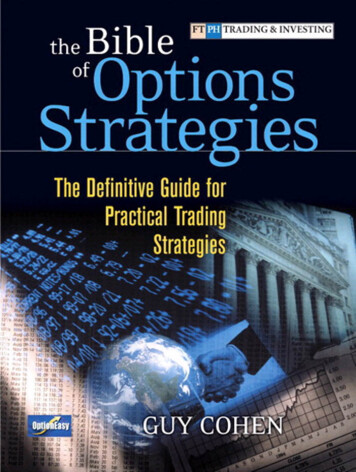
Transcription
BUSINESS STRATEGIES OF THE MULTINATIONALCORPORATIONS*Laura DiaconuAlexandru Ioan Cuza University of Iaşi, Româniadlaura es@yahoo.comAbstract: The international strategic management facilitates the development of the internationalstrategies that shape a large context for reaching the main goals of a multinational company. At aconceptual level, there are many similarities between designing a strategy that could be used only in onecountry and drawing up a strategy for a number of markets. Yet, it has to be mentioned that the developmentof an international strategy involves a more complex process than in the case of a national one. All theseaspects, together with the determinants of the internationalization, will be largely argued in the presentpaper.Keywords: multinational corporations, international strategies, business internationalizationJEL Classification: F23INTRODUCTIONThe international operations management consists in those transforming activities, inside aninternational firm, meant to process different types of inputs in order to create final goods andservices. This type of management involves the development of various international strategies thatshape a large context in which a firm reaches its main objectives. At a conceptual level, there aremany similarities between designing a strategy that could be used only in one country and creating astrategy for a number of markets. In both situations, those that make the strategic planning have toanswer some fundamental questions related to what kind of products or services does the firmintend to sell, where and how will it make these products, where and how it will sell them, where itwill obtain the necessary resources or how does it expect the competitors to react.Considering all these aspects, it has to be mentioned that the development of an internationalstrategy involves a much more complex process than the development of a national one. First of all,the managers responsible with the development of an international strategy will have to face manytypes of political and/or legal systems, various accounting regulations, cultures or languages andeven many payment systems. Moreover, the managers of an international business have to*ACKNOWLEDGMENT: This work was supported from the European Social Fund through Sectoral OperationalProgramme Human Resources Development 2007-2013, project number POSDRU/1.5/S/59184 „Performance andexcellence in postdoctoral research in Romanian economics science domain”CES Working Papers, IV, (2), 2012141
coordinate and implement the firm’s strategy in all its subsidiaries, located in different parts of theworld, with different economic, social and cultural contexts. Despite all of these, the managersusually say that the aspects mentioned above are only some inherent problems when considering theopportunities of the global expansion.The paper presents, with the help of some relevant examples from the Romanian and worldwide practice, the essential aspects that should be considered when choosing an internationalstrategy. In the end, some characteristics are pointed out for the strategies implemented by themultinationals that have entered the Romanian market.1.CHOOSING AN INTERNATIONAL STRATEGYAs B. Lovas and S. Goshal noted, the international business offers the possibility ofexploiting three sources of the competitive advantage, unavailable for the national companies:global efficiencies, the multinational flexibility and worldwide learning process (Lovas andGhoshal, 2000, pp. 875-896). The multinational firm can improve its efficiency either through itslocation advantages, or through the scope or scale economies. The first ones appear when locatingthe production subsidiaries in any place of the world, in order to have the lowest cost of productionor distribution, or the highest quality of goods and services. For example, the production of toys isintensive in the labor factor and this is why Wal-Mart, as well as many other companies, hasestablished its production in those countries where there is low-cost labor force. The same happenedwith Nokia that has chosen to locate in 2008 one of its production subsidiaries in a rural area ofRomania, closed to Cluj, or with the American company Selectron, which has invested 20 milliondollars in building a plant in Timişoara in 2003-2004. In a similar way, the multinationals mayreduce their costs achieving scale economies. Moreover, by expanding the production lines in everycountry they enter, the companies may also enjoy scope economies. In this situation, not only dothey cut the production and marketing costs, but also they intensify the lowest line-levels.The international business might require a deeper degree of flexibility due to the fact that thepolitical, economic, legal or cultural environment of a state is continually changing. For example,let us think about the case of Romania that, since 1989, is passing through a long and difficulttransition process; during these 22 years, the economy was marked by many political and legislativechanges and only the firms that were able to face these transformations have survived.CES Working Papers, IV, (2), 2012142
The various environments in which the multinationals choose to do their business may alsoimprove the organizational learning process. The differences between the environments in whichcompanies act may determine them to match their behavior to the specific of the host country. Agood example for this is United States where there are various sub-cultures that belong to differentethnic and religious groups, each of them influencing the manner in which the businesses develop.This is why Campbell sells different types of tomato soup, according to the region it addresses: inMontana, for example, the soup is less spiced than that sold in Texas. Following the same reason, inorder to penetrate various countries the well-known multinational firm, McDonald’s, had to adaptits menu to the local food preferences and customs. In Israel, for example, the company uses“kosher” menus, while in the Arab countries the restaurants’ chain is preparing “Halal” menus. InIndia, McDonald's offersthe Big Mac made with lamb, called the Maharaja Mac.The practice shows that it is difficult to exploit simultaneously all these three factors. Yet, inorder to reach equilibrium between the three objectives, the multinationals often adopts one of thefour alternative strategies: the national, multidomestic, transnational or global strategy. In the caseof the national strategy, the firm uses its specific advantages, obtained in the home country, in orderto compete on the foreign markets it enters. For example, Chrysler counts on its well-known nameand reputation when producing sport or elegant cars, well equipped and very safe at high speed.This is the niche that the company has chosen to exploit at an international level, although there areonly few countries that have the infrastructure, the level of incomes and the speed required by thesecars and permitted by law.A second option for a company may be the multidomestic strategy. The multidomesticcorporation is considered to be a sum of relative independent subsidiaries, each of them focusing ona well determined market. This multidomestic approach is advisable when there are significantdifferences between national markets, when the scale economies are reduced, or when the cost ofcoordinating the activity among the parent firm and the subsidiary is high. A multidomestic approachcan be found in the case of the firm RSB-Roundtech that produces industrial material necessary forcircular structures, for water, gas or telecommunications. The company, with headquarter closed tothe Constance Lake, in the industrial area between Austria, Germany and Switzerland, has openedsubsidiaries in Germany, Hungary, Japan and Switzerland. Due to the fact that it has only 20 peopleworking into headquarter, it was vital for the firm to choose the proper strategy to enter eachcountry. The main problem the managers confronted with was the fact that each market had its ownCES Working Papers, IV, (2), 2012143
specific characteristics, according to which each subsidiary of the company has lately developed itsstrategy and designed its products.Adopting the global strategy, the firm approaches the world as a single market, the mainscope being the development of standardized goods and services that answer the needs of the worldwide consumers. The company tries to achieve scale economies in marketing and production byconcentrating its production activities in its most efficient subsidiaries and then, by developingsome global marketing campaigns in order to sell them. Due to the fact that the global company hasto coordinate the world-wide production and marketing strategies, it focuses the power anddecisions’ responsibility in the central location. At the beginning of the 1980, Ford wanted to createa car for all the tastes, from Detroit to Hong-Kong. So, it started to produce the Ford Escort model,which did not have a great success. This is why, after a few years, they created two versions of thismodel: Mondeo for Europe and Tempo in USA, which differed one from the other in a proportionof 25%. These new versions, due to the fact that they were more focused on the characteristics ofthe two continents, have brought a great success to the firm.Ghoshal identifies three strategic objectives into any global strategy and also three mainaspects of the competitive advantages, involved by the global strategy (Ghoshal, 1987, pp. 425440). The results of such an approach are shown in the table 1.Table 1 - Global strategy: organizational frameworkStrategicobjectivesEfficiency incurrentoperationsRiskmanagementLearning andinnovationSources of the competitive advantageDifferences betweenScale economiescountriesDifferences in the costScale economies in eachof the factors ofactivityproductionEstablishing the riskEquilibrium between theaccording to thestrategic, operational andcountryscale flexibilityLearning from theOpportunities for reducingcultural varietythe technological costsScope economiesCommon use of the resourcesand the capacities of marketsor productsPortfolio diversificationSpreading out theorganizational learningprocessSource: Ghoshal (1987)As it results from the above table, the three main objectives of a global strategy – theefficiency, the risk management, learning and innovation – are correlated to three essential sourcesof the competitive advantage:CES Working Papers, IV, (2), 2012144
Differences between nations: the competitive advantage may result from the exploitation ofthe differences related to the input and output market from various countries; the countries withlow-wages are the most eloquent for this. The scale economies are a source of the competitive advantage if the firm is able to adopt aconfiguration of its activities which allows the lowest unitary cost per each activity. The scope economies appear when the resources used to produce or to sell a good in acountry may be used for the same purpose in the case of other goods, from other countries.Some analysts, like Theodore Levitt, consider that the globalization of the products will be thesuccessful strategy for the future international business (Levitt, 1986). They give examples ofglobal products such as Coca-Cola drinks, Sony TVs or McDonald’s restaurants. But, it has to bementioned that even these global products, with almost the same characteristics, were somehowchanged before being sold on foreign markets. For example, in Germany, the McDonald’srestaurants include beer in the menu and in France they offer wine.The fourth strategic alternative for a multinational firm consists in the transnational strategy.In this situation, the firm tries to combine the benefits of the global efficiencies – also obtained bythe global corporation – with the local advantages – a purpose also specific for the multidomesticfirm. So, the transnational corporation does not centralize or decentralize the authority, but it settlesresponsibilities, for each organizational task, to that unit of the organization that could be able toreach out the purpose of efficiency and flexibility. A good example for this type of strategy can befound in the case of the Harley-Davidson, which has as a motto “Think global but act local”.According to this marketing principle, Harley-Davidson not only adapts its products to the differentcontinents, but also it operates changes when addressing different countries from the samecontinent.2.IMPLEMENTING AN INTERNATIONAL STRATEGYNo matter what is the decision regarding the type of the international strategy, the managershave to point out the four main elements in the development of a strategy: the distinctivecompetences, the purpose of the operations, the resource development and the synergy (Griffin andPustay, 2005, p. 490). The first aspect of an international strategy – the distinctive competences –may refer either to the last-minute technology, to the efficient red of distributors, to betterorganizational practices, or to the well-known brand name. Having a distinctive competence –CES Working Papers, IV, (2), 2012145
called by Dunning, in his eclectic theory, the “ownership advantage” – is considered, by manyexperts, a necessary condition for a firm to have success on a foreign market.The second component of an international strategy – the scope of operations – generally refersto geographical regions such as countries, parts of a country of even a group of states. At the sametime, the scope has to be focused on some markets or product’s niches from one or many regions.The scope is also related to the distinctive competences: if a firm has an advantage only in a specificregion or only for a certain product line, then the scope has to be focused on that region where thecompany enjoys the distinctive competence.The resource development process involves setting the priorities, especially
to coordinate the world-wide production and marketing strategies, it focuses the power and decisions’ responsibility in the central location. At the beginning of the 1980, Ford wanted to create a car for all the tastes, from Detroit to Hong-Kong. So, it started to produce the Ford Escort model, which did not have a great success. This is why, after a few years, they created two versions of thisFile Size: 404KBAuthor: Laura DiaconuPage Count: 11Publish Year: 2012People also search forlist of multinational corporation











